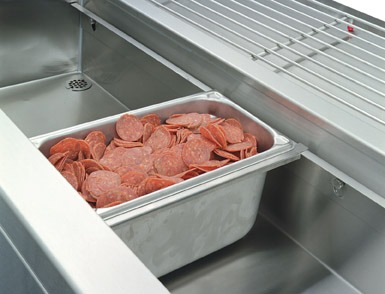 If you’ve ever worked in foodservice, chances are you might have heard the phrase, “If you’ve got time to lean, you’ve got time to clean!”
If you’ve ever worked in foodservice, chances are you might have heard the phrase, “If you’ve got time to lean, you’ve got time to clean!”
Translation: You shouldn’t be standing around with nothing to do because we’ve got stuff we need to clean!
Managing a consistent cleaning program can be a constant challenge for any foodservice operator, simply because there are so many surfaces and items that need to be thoroughly cleaned at all times to prevent the growth of dangerous bacteria and foodborne illness. You also need to train your staff how to break down equipment so they can clean behind all of those hard-to-reach places that you can’t see.
Unfortunately, equipment that is difficult to take apart is likely the last to be cleaned or worse – it doesn’t get cleaned at all! The best kitchen equipment comes with parts that are easy to remove (and don’t require tools to disassemble), promoting ease of cleanability.
Aside from cleaning dishes and utensils each day, ovens and racks need to be cleaned, sinks and faucets have to be delimed and any surface that comes in contact with food must be properly cleaned and sanitized. A daily cleaning checklist might also include sweeping and mopping floors, washing tabletops, chairs and booths, emptying trash and cleaning and sanitizing restrooms. On top of that, there are other deep-cleaning requirements that must be managed on a monthly basis, such as washing behind equipment, cleaning grease traps, hood filters, refrigerators and freezers, as well as windows, doors, light fixtures, walls and ceilings in the front of the house.
It all can be a lot to handle, especially during peak hours of foodservice. While necessary, the labor expense required can quickly add up as more time is allocated to address the cleanup process effectively. Alternatively, you can also choose cooking equipment that’s less tedious to clean, improving safety and saving you time and money in the process.
Because prep tables are one of the most active parts of any kitchen, it can be incredibly time consuming to clean. Many prep table models on the market today are designed with multiple removable parts and pieces which create nooks and crannies, making these units very difficult and time consuming to clean properly.
Randell’s cold-wall cooled prep tables promote the type of safe and efficient cleaning that can help busy foodservice operations optimize their cleaning and sanitation practices.
The secret is a completely sealed pan rail opening that keeps food spills within the rail. One of the major benefits of this feature is that it does not require any complicated parts and pieces that must be removed and replaced during and after cleaning like other prep tables.
Other pan rails on prep tables can have multiple parts that are difficult to handle and contain sharp edges. Some of these prep tables have to be completely shut off in order to clean. This means you might have to assign additional labor to transfer the food to an alternative cold storage unit because your food won’t be staying at the right temperature.
Randell prep table pan rails are completely sealed because they utilize conductive cold-wall cooling. There are no air vents, which in addition to being difficult to clean, can also collect food and inhibit performance. A standard clean-out port makes cleaning simple because you can wash and sanitize the rail and drain the cleaning fluid into a bucket, saving valuable time and labor while ensuring cleanliness.
Staying on top of all the moving pieces that go into a successful washing and sanitizing program can be daunting, but can be made easier when you select equipment that is designed to improve and streamline the process.
Dave Rademacher
Product Specialist-Refrigeration
(601) 371-6029
[email protected]